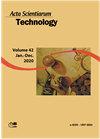Canonical correlation analysis applied to regulated deficit irrigation in ‘Tommy Atkins’ mango trees
IF 0.6
4区 综合性期刊
Q3 MULTIDISCIPLINARY SCIENCES
引用次数: 0
Abstract
The objective was to identify the effect of regulated deficit irrigation on physiological, yield and root descriptors of ‘Tommy Atkins’ mango tree grown in a semi-arid region of Brazil. The work was carried out during two production cycles on an 11-year-old mango orchard. The design was randomized blocks with five treatments and six replications. Irrigation treatments were based on the trees’ development stage: T1, irrigation supplying 100% of the crop evapotranspiration (ETc) in three production stages: fruit set stage (SI), fruit expansion stage (SII), and physiological maturation stage of the fruits (SIII); T2, 50% ETc in SI and 100% ETc in SII and SIII; T3, 100% ETc in SI and SIII and 50% ETc in SII; T4, 100% ETc in SI and SII, and 50% ETc in SIII; and T5, without irrigation in all three stages. Physiological data were measured once per stage. After harvesting the second cycle, roots were collected, following a completely randomized design, with five treatments and three replications, to determine the total root length density. Total or partial water deficit in ‘Tommy Atkins’ mango trees was identified by decreasing transpiration (E) and photosynthesis (A) and increasing leaf temperature (Tleaf). The total root length density is similar in all irrigation strategies up to 1 m horizontal distance and 0.10 m depth. Water deficit applied in the physiological maturation stage improves yield and water use efficiency.典型相关分析在“Tommy Atkins”芒果树调节亏缺灌溉中的应用
目的是确定调节亏缺灌溉对生长在巴西半干旱地区的“Tommy Atkins”芒果树的生理、产量和根系描述的影响。这项工作分两个生产周期在一个有11年历史的芒果果园进行。设计为随机分组,5个处理,6个重复。灌溉处理以树木发育阶段T1为基础,在坐果期(SI)、果实膨大期(SII)和果实生理成熟期(SIII) 3个生产阶段提供100%作物蒸散量(ETc)灌溉;T2, 50% ETc在SI和100% ETc在SII和SIII;T3,在SI和SIII中100% ETc,在SII中50% ETc;T4, SI和SII组100% ETc, SIII组50% ETc;T5,三个阶段均不灌水。每个阶段测量一次生理数据。第二周期收获后,采根,采用完全随机设计,5个处理,3个重复,以确定总根长密度。通过蒸腾作用(E)和光合作用(A)的降低和叶温(leaf)的升高,可以确定“Tommy Atkins”芒果树的全部或部分水分亏缺。在1 m水平距离和0.10 m深度范围内,所有灌溉策略的总根长密度相似。生理成熟期水分亏缺可提高产量和水分利用效率。
本文章由计算机程序翻译,如有差异,请以英文原文为准。
求助全文
约1分钟内获得全文
求助全文
来源期刊

Acta Scientiarum-technology
综合性期刊-综合性期刊
CiteScore
1.40
自引率
12.50%
发文量
60
审稿时长
6-12 weeks
期刊介绍:
The journal publishes original articles in all areas of Technology, including: Engineerings, Physics, Chemistry, Mathematics, Statistics, Geosciences and Computation Sciences.
To establish the public inscription of knowledge and its preservation; To publish results of research comprising ideas and new scientific suggestions; To publicize worldwide information and knowledge produced by the scientific community; To speech the process of scientific communication in Technology.
 求助内容:
求助内容: 应助结果提醒方式:
应助结果提醒方式:


